No, I’m not talking about books of the “guide to busking” or “how to make money” or “self help” ilk. Those are for opportunists selling bunkum to people looking for shortcuts.
The busker books below are different. They are a mix of philosophy, protest, insights and planning, which may help explain your little slice of life in the big context of “the city”, and will definitely improve your arguments over why your mayor shouldn’t ban you.
These books cover everything from the systems within and around street performance that make it possible, to every day life as a busker, to who controls our public spaces, and what we want public space to achieve.
In short, the below 13 books are amazing. Have we missed any? Let us know in the comments.
Human and Interesting Research on Busking
These three books are required reading for anyone who’s even tangentially interested in the lives, troubles and legal grey areas that buskers inhabit. Not exactly the perfect guide to busking (these are more academic or historical rather than DIY-focused), but they are full of personal stories, interviews, interpretation and some stats to back it up, they are the three fundamental books on busking that everyone should read!
—
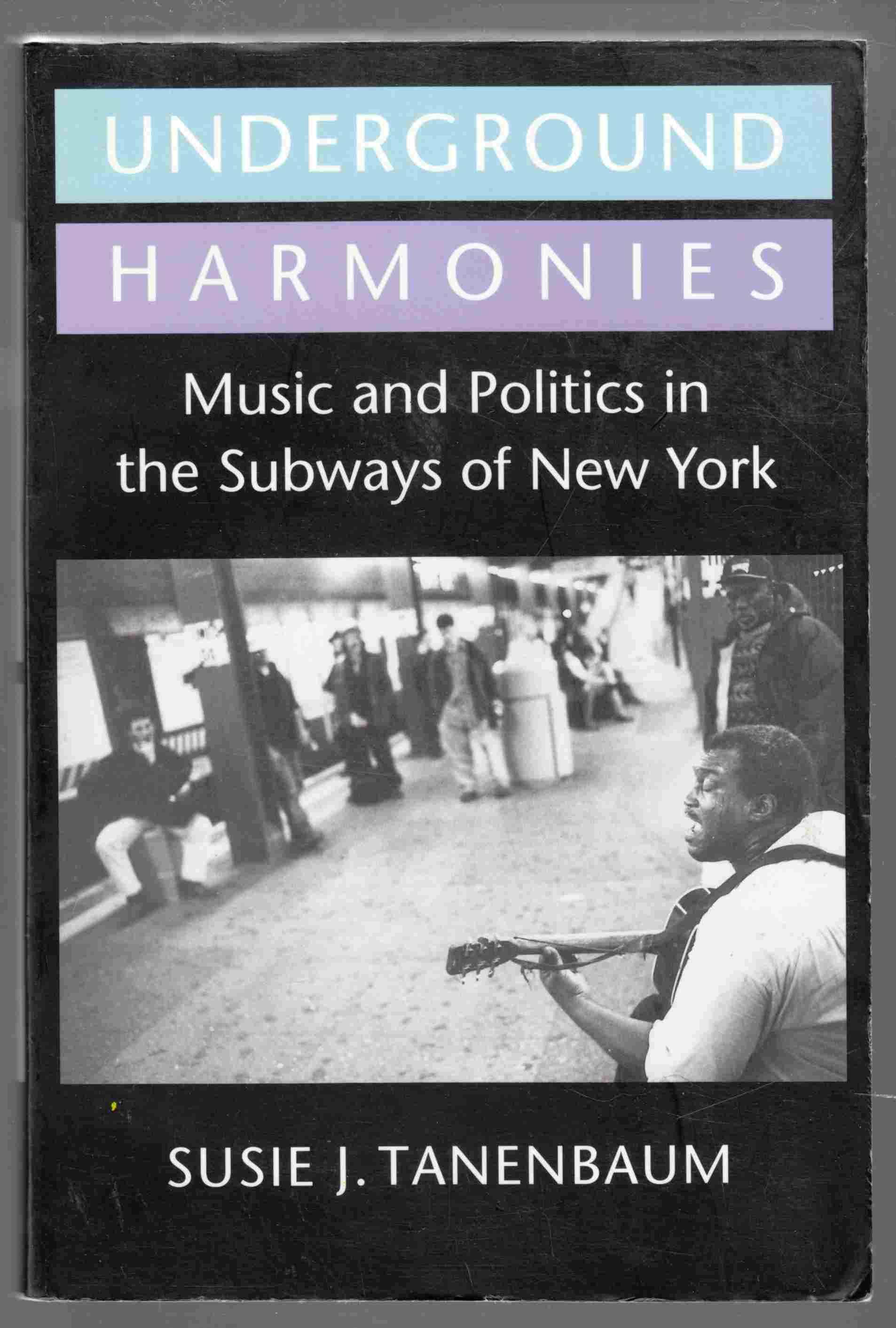 Underground Harmonies: Music and Politics in the Subways of New York
Underground Harmonies: Music and Politics in the Subways of New York
– Suzie J. Tanenbaum, 1995
This is the first book on New York’s subway musicians – modern troubadours who perform on platforms, mezzanines, and even trains pounding through the city. Illustrating her account with captivating photos, Susie J. Tanenbaum draws on interviews with musicians and their audiences to explore both the vibrant culture and the intricate politics of subway music.
Underground Harmonies is the story of music-making in the New York City subways in the 1980s and 1990s. It is a collective portrait of subway musicians and their audiences, and of the city and transit authority personnel who try to manage what are essentially spontaneous interactions between these underground musicians and their listeners.
Tanenbaum examines the significance of these interactions, pointing out that “Subway music scenes raise a number of provocative questions. Who decides what legitimate community and culture are? Who decides where they can exist? What are the appropriate uses of public space?”
—
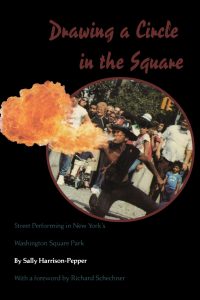 Drawing a Circle in the Square: Street Performing in New York’s Washington Square Park
Drawing a Circle in the Square: Street Performing in New York’s Washington Square Park
– Sally Harrison-Pepper, 2010
This is a joyful book focusing upon the street performers in Washington Square Park in New York City. While documenting the complex expressions of street performance in a specific outdoor environment over a period of four years, Drawing a Circle in a Square gives a broad examination to the relationship between outdoor performance and urban culture. In this book we learn that most American cities prohibit street performance, charging such entertainers with vagrancy or soliciting, the performer – joyfully, cautiously, heroically – persists.
On sidewalks throughout the country, in theatres reduced to their barest essentials, the performer juggles, blows fire, performs magic, and tells jokes, appealing both to our sense of humour and to our longing for a moment of spontaneity in our city-structured lives.
Drawing a Circle in the Square is the first scholarly documentation and analysis of street performance. Based primarily upon original research, it makes a contribution that is as much toward a particular subject. Promoting the study of performance as an important and valuable vehicle for inter-disciplinary research and thought, it is a model of the kinds of research being developed in the emerging field of performance studies.
—
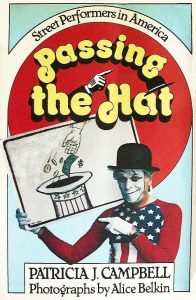 Passing the hat: Street performers in America
Passing the hat: Street performers in America
– Patricia J. Campbell, 1981
Passing the Hat is a joyful celebration of an ancient tradition. As long as there have been streets, there have been buskers – entertainers who can stand up on the sidewalk or in a park and sing, dance, juggle or perform magic, music of mime – anything that will draw a crowd and hold it within the performers’ spell.
Patricia Campbell and Alice Belkin take you on a tour of the buskers’ best spots – from Boston and New York to New Orleans and San Francisco, and a dozen places in between. It is a journey that reveals not only a performer’s fierce need for freedom, but the dedication, skill and years of discipline behind any good act. The story of busking is one of learning to love each failure, to conquer mistakes, to master a crowd, and to make it all pay off – in applause and sometimes in a decent living.
—
Analyses of Street Performance Itself
These three books have been, of course, written by buskers. If you are a festival producer, or just looking to be able to speak about street performers in more professional terms, these are the books for you. Weirdly, they’re a little more… “dry” (as in, not quite so exciting) as some of the other books on this list, BUT that speaks more to their professionalism than the quality of writing, which is really high! Bim Mason’s and David Cassel’s books together are the perfect busker books – essential reading for the budding professional street performer.
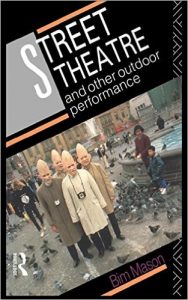 Street Theatre and Other Outdoor Performance
Street Theatre and Other Outdoor Performance
– Bim Mason, 1992
This book is a description, a celebration and an analysis of outdoor theatre, which demonstrates just what a sophisticated art form it is. It provides a practical guide to those who are new to the subject and enables practising performers to additional new insight on their own work. It also provides arts administrators and festival organisers with the information they need to programme outdoor performances successfully.
Bim Mason describes some of the less well known methods as well as examining the performance practices of some of the most established British and European companies. He shows how the contemporary scene has been arrived at, and explores the ways in which outdoor performance continues to challenge and dissolve our definitions of “theatre”.
—
 The Buskers: History of Street Entertainment
The Buskers: History of Street Entertainment
– David Cohen & Ben Greenwood, 1981
Street entertainment has its own surprisingly rich history; a tradition which has brought a humanising influence to city environments throughout the ages. The Buskers traces the fortunes, and often dubious social position, of a wide range of fascinating performers, such as the Classical pantomime actor, the Anglo-Saxon scop, the courtly troubadour, the mountebank selling quack medicine, the Victorian organ-grinder, and the contemporary busker.
Mostly it is a story of struggle, for society’s attitude towards the itinerant performer has always been ambivalent. The patronage of kings and courtiers brought privileges and honour to a favoured few, but unprotected entertainers were often hounded from town to town, labelled as vagrants. They have been repressed by institutions as diverse as the Roman Catholic Church and puritan parliaments, but prohibition has only increased the ingenuity of their efforts to bring enjoyment into the streets.
The tradition survives today, and the authors have been able to bring their history right up-to-date by talking to many of the characters of modern busking, and photographing them in action, wherever an audience can be found. It is an enthralling account that will provide the reader with a sympathetic understanding of the street entertainers’ place in the history of urban society.
—
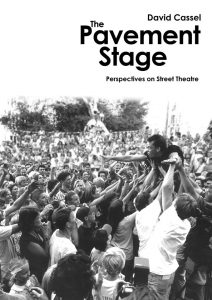 The Pavement Stage: Perspectives on Street Theatre
The Pavement Stage: Perspectives on Street Theatre
– David Cassel, 2012
The Pavement Stage is my personal favourite of these three. It’s an exploration of outdoor performance in all of its different forms and provides an in depth overview to a world and lifestyle unlike any other.
From 1979 through to the present, David Cassel has travelled around the world to over 40 countries creating, presenting and experiencing a wide range of solo and ensemble street performances. His voyages have revealed some fascinating insight into the techniques and performance styles used by himself and some of the other personalities that have populated this extremely vital and satisfying form of public interaction and community development.
As street performance has grown in popularity internationally so has the civic policy that governs the public space in almost every city on the globe. While some cities celebrate the form through festival, others outlaw it. Why does street performance create such an extreme reaction, are street performers anarchists?
Buy it here
—
Urbanism, Placemaking and Who Controls the Streets
You cannot have a deep conversation about the rights of street performers without knowing how our cities are transforming, why they’re changing and what forces are behind it. These four books do exactly that, and, as well, set up the need for a system of cultural urban planning (a.k.a. “placemaking”) that ensures that governments don’t forget that people and communities are important! These aren’t so much “busker books” as a “guide to why busking is important – now more than ever”.
 Ground Control: Fear and happiness in the twenty-first-century city
Ground Control: Fear and happiness in the twenty-first-century city
– Anna Minton, 2012
If you ever wondered who controlled the streets and why, this is the book for you. Why is it that there’s a massive increase in security guards? Why all the new laws? Why now?
Britain’s streets have been transformed by the construction of new property – but it’s owned by private corporations, designed for profit and watched over by CCTV. Have these gleaming business districts, mega malls and gated developments led to ‘regeneration’, or have they intensified social divisions and made us more fearful of each other?
Anna Minton’s acclaimed and passionate polemic, now exploring the policies of the new government and London’s controversial Olympic Part, shows us the face of Britain today. It reveals the untested – and unwanted – urban planning that is changing not only our cities, but the nature of public space, of citizenship and of trust.
—
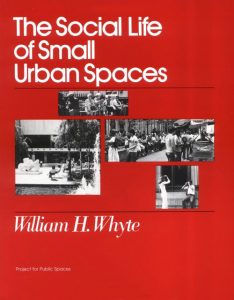 The Social Life of Small Urban Spaces
The Social Life of Small Urban Spaces
– William H. Whyte, 1980
In 1980, William H. Whyte (affectionately known as “Holly”) published the findings from his revolutionary Street Life Project in The Social Life of Small Urban Spaces. Both the book and the accompanying film were instantly labeled classics, and launched a mini-revolution in the planning and study of public spaces. They have since become standard texts, and appear on syllabi and reading lists in urban planning, sociology, environmental design, and architecture departments around the world.
Project for Public Spaces, which grew out of Holly’s Street Life Project and continues his work around the world, has acquired the reprint rights to Social Life, with the intent of making it available to the widest possible audience and ensuring that the Whyte family receive their fair share of Holly’s legacy.
This book “birthed” the Placemaking movement, and is arguably the most important text on why public interaction is important in public spaces! And yes, both Holly and the Project for Public Spaces were/are massive fans of street performance.
—
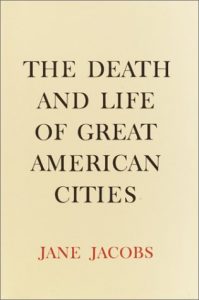 The Death and Life of Great American Cities
The Death and Life of Great American Cities
– Jane Jacobs, 1961
This one isn’t explicit in its support of street performers. However, Jacobs is famous for showing the importance of having “eyes on the street” – locals who are clued in to what’s going on around them. Buskers are the perfect example of those eyes. And, as this seminal work has been massively influential in many different realms, it would do you good to get to know it.
A direct and fundamentally optimistic indictment of the short-sightedness and intellectual arrogance that has characterised much of urban planning in this century, The Death and Life of Great American Cities has, since its first publication in 1961, become the standard against which all endeavours in that field are measured.
In prose of outstanding immediacy, Jane Jacobs writes about what makes streets safe or unsafe; about what constitutes a neighbourhood, and what function it serves within the larger organism of the city; about why some neighbourhoods remain impoverished while others regenerate themselves.
She writes about the salutary role of funeral parlours and tenement windows, the dangers of too much development money and too little diversity. Compassionate, bracingly indignant, and always keenly detailed, Jane Jacobs’s monumental work provides an essential framework for assessing the vitality of all cities.
—
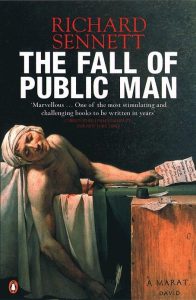 The Fall of Public Man
The Fall of Public Man
– Richard Sennett, 1977
The next three paragraphs are going to sound absolutely depressing. That’s because they are. However, this is the context in which you exist – in a world where we’ve lost the essential human contact we once had. Seen in that light, you buskers are absolutely saviours.
“Public” life once meant that vital part one’s life outside the circle of family and close friends. Connecting with strangers in an emotionally satisfying way and yet remaining aloof from them was seen as the means by which the human animal was transformed into the social – the civilised – being. And the fullest flowering of that public life was realised in the 18th Century in the great capital cities of Europe.
Sennett shows how our lives today are bereft of the pleasures and reinforcements of this lost interchange with fellow citizens. He shows how, today, the stranger is a threatening figure; how silence and observation have become the only ways to experience public life, especially street life, without feeling overwhelmed ; how each person believes in the right, in public, to be left alone.
And he makes clear how, because of the change in public life, private life becomes distorted as we of necessity focus more and more on ourselves, on increasingly narcissistic forms of intimacy and self-absorption. Because of this, our personalities cannot fully develop: we lack much of the ease, the spirit of play, the kind of discretion that would allow us real and pleasurable relationships with those whom we may never know intimately.
—
Busker Memoirs
I’m going to lose friends by only posting two here. There are lots and lots of really well-written memoirs. The Subway Diaries is one I particularly enjoyed, but there are many more, some good, some bad (and some absolutely terrible). The two I’ve selected below I chose partly because I think they had good editors and were well written, and partly because their stories really are fascinating.
 Buskers: The On-the-Streets, In-the-Trains, Off-the-Grid Memoir of Two New York City Street Musicians
Buskers: The On-the-Streets, In-the-Trains, Off-the-Grid Memoir of Two New York City Street Musicians
– Heth & Jed Weinstein, 2011
Frustrated by the indifference of the music industry and the stacks of homemade CDs gathering dust in their closets, brothers Heth and Jed Weinstein made the radical decision to bring their music directly to the masses. They began playing on street corners, in subway stations, and wherever else they could connect with a live audience.
To their surprise, far from this being the terminal stop of a dead-end career, busking turned out to be just the beginning as crowds of stressed-out commuters gathered around, cheering them on, subscribing to their mailing lists, and actually buying some of those stockpiled CDs—40,000 and counting.
In Buskers, Heth and Jed recount their turbulent, drug- and crime-filled adolescence in the nowhere-land of Livingston, New Jersey, their valiant attempts to achieve rock ’n’ roll success through traditional channels, and their unexpected path to circumventing the outmoded music industry. They divulge fascinating details about the technical and legal aspects of street performance, New York busking culture, and the lives of their fellow troubadours.
A world of possibilities opens up when the brothers take it to the streets, proving the value of their music to themselves and anyone who’ll listen. Read their story, and your commute will never be the same.
—
 The Art of Asking: Or How I Learned to Stop Worrying and Let People Help
The Art of Asking: Or How I Learned to Stop Worrying and Let People Help
– Amanda Palmer, 2014
Rock star, crowdfunding pioneer, and TED speaker Amanda Palmer knows all about asking. Performing as a living statue in a wedding dress, she wordlessly asked thousands of passersby for their dollars. When she became a singer, songwriter, and musician, she was not afraid to ask her audience to support her as she surfed the crowd (and slept on their couches while touring). And when she left her record label to strike out on her own, she asked her fans to support her in making an album, leading to the world’s most successful music Kickstarter.
Even while Amanda is both celebrated and attacked for her fearlessness in asking for help, she finds that there are important things she cannot ask for-as a musician, as a friend, and as a wife. She learns that she isn’t alone in this, that so many people are afraid to ask for help, and it paralyses their lives and relationships. In this groundbreaking book, she explores these barriers in her own life and in the lives of those around her, and discovers the emotional, philosophical, and practical aspects of THE ART OF ASKING.
Part manifesto, part revelation, this is the story of an artist struggling with the new rules of exchange in the twenty-first century, both on and off the Internet. THE ART OF ASKING will inspire readers to rethink their own ideas about asking, giving, art, and love.
—
And best of all?
The Busking Project: The Health of Busking in Cities Around the World
– Nick Broad, Belle Crawford and Chris Smith, 2014
Last but not least, this is the book we created of our trip filming and interviewing hundreds of street performers in 40 cities in 30 countries on 5 continents. Perhaps our best review was an Irish guitarist who I gave a copy to, who brought it back to me the next day and said “You know what, this book explained my life to me.”
Taken from over 45,000 photos we took on the trip, this book gives a unique, beautiful look at the world of busking, split into four main sections:
• Part 1: Malls Without Walls, exploring how busking is having to deal with an increasingly privatised public domain, and how bad policy is affecting buskers lives on the ground.
• Part 2: Freedom of Expression, where we look at the motivations and eccentricities of street performers, and the politics of putting yourself out there.
• Part 3: Challenging Assumptions, taking apart some of the common misconceptions people have about street performers
• Part 4: The Busking Project, where we tell our readers how we managed to capture this footage, and what The Busking Project is all about.
HOW CAN YOU BUY A COPY? Just register, and we’ll give you a free download 🙂
Okay!
That’s it. Let us know what other books on busking you love. I’ll see if I can buy a copy, and maybe make another list?
nick x
